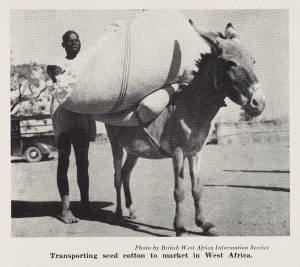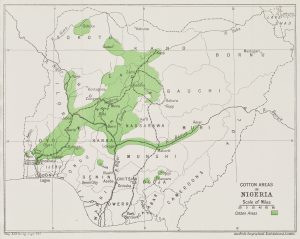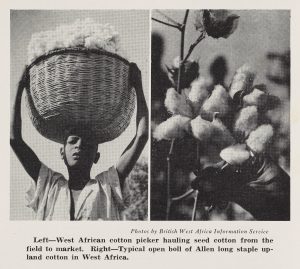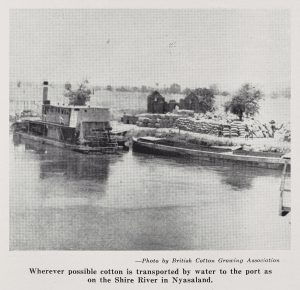March 20, 2018, by Kathryn Steenson
The Cotton Research Corporation Library
The Cotton Research Corporation’s papers and library of printed materials came to the University of Nottingham Library in the 1970s. During its institutional history the Corporation increasingly abandoned direct involvement in cotton growing projects and directed its attention toward research, building up a library of printed materials. Now in the process of being catalogued, the materials from the Cotton Research Corporation Library can be browsed online using NUsearch with the field ‘Collection’ and the name ‘Cotton Research Corporation Library’ itself, or the acronym ‘CRCL’.
The CRCL publications focus mainly on scientific and economic research into cotton farming in Africa. A substantial part of the Library is dedicated to the study of diseases and pests affecting the cotton crop-plant and of soil conditions and irrigation in the relevant environments. For scientific purposes the publications are often illustrated with photographs and other graphic material. These vary in production value but have potentially high documentary value as they capture landscape, agricultural workers and farming conditions in former British and other colonies throughout the 20th century. The information value of images from publications which are primarily focused on agronomic processes holds further interest for interdisciplinary research. For example, for postcolonial studies the collection can be researched as a bank of documents from various stages of colonial rule and decolonisation.
The CRCL contains material on industries beside cotton, such as the commercial cultivation of peanuts, tobacco, sugarcane and local trades such as fishing. This literature was relevant to the Corporation because revenues from alternative crops could outcompete cotton and cause slumps in the cotton supply from African countries which the Corporation sought to sustain. The Corporation’s non-governmental predecessor, the British Cotton Growing Association (1902-1921), pursued this proactively to the extent of paying African farmers at least market rates, and, when worldwide cotton prices slumped, even above-market rates, to ensure growers did not stop growing cotton. Cash incentives were also used to maintain the production of high-quality cotton, in demand at home.
The BCGA also encouraged the British Government to invest in infrastructure projects in the colonies likely to benefit cotton production, such as roads, railways and irrigation works, including the Sennar Dam in Sudan and the expansion of Nigeria’s Railways. Thus, it laid the groundwork for the Empire Cotton Growing Corporation, which focused increasingly on development. Monographs about local infrastructure development concerning transport, public health, housing and welfare are consistent with the historic agency of the CRCL.
The value of this Library to research in the Humanities lies in its trove of information about the British Empire in Africa. The Library can advance research into the ideology which underpinned these manifestations of colonial rule. Cultural constructs and their applications from this still recent chapter of history are recorded therein. They can be detected in reports such as the ‘Official report of the visit of the delegation of the International Federation of Master Cotton Spinners’ and Manufacturers’ Associations to Egypt, October-November, 1912 and report by the secretary on his subsequent tour in the Anglo-Egyptian Sudan, November-December, 1912’, a richly illustrated document of its time prefaced by the Governor-General of Sudan, Sir Francis Reginald Wingate. They can be traced in the influential book published by Frederick Lugard in 1922, ‘The Dual Mandate’, of which the CRCL has a first edition.
Lugard, then governor of Nigeria, famously (and erroneously) argued that history or culture are absent from Africa: “Africa has been justly termed ‘the Dark Continent’, for the secrets of its peoples, its lakes, and mountains and rivers, have remained undisclosed not merely to modern civilisation, but through all the ages of which history has any record. There are many regions in Asia — in Persia, Assyria, Arabia, and Western China — in which modern explorers have claimed to have made discoveries. But all these countries were the seats of ancient civilisations, some of them highly developed, and exploration was concerned rather with piecing together chapters of past history than in discovery. The penetration into the interior of Africa, on the other hand, may as truly be described as discovery as that of America by Columbus.” In sub-Saharan Africa, he writes, “there are no traces of antecedent civilisations — no monuments or buried cities — like those of the prehistoric civilisations of Asia and South America.”
Most important and unique to this Special Collection is the visual content captured inadvertently in images taken on location and used to illustrate scientific literature. These images lend themselves to research as historic documents of a counter-narrative, the camera often capturing more life and evoking a different side to the reality it was meant to illustrate.
The CRCL is available to view in the Reading Room at Manuscripts & Special Collections, King’s Meadow Campus. To make an appointment, please contact us on mss-library@nottingham.ac.uk. For more information about our holdings, see our website or follow us on Twitter @mssUniNott.
No comments yet, fill out a comment to be the first





Leave a Reply